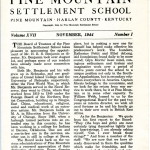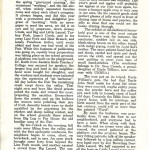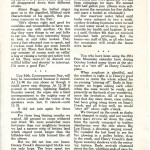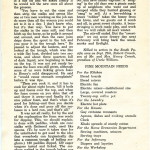Pine Mountain Settlement School
Series 17: PUBLICATIONS PMSS
NOTES 1944
November
NOTES – 1944
“Notes from the Pine Mountain Settlement School”
November
GALLERY
Captain [Glyn] Morris belongs to the mountains, and we look for his return from war service to work there, be it at Pine Mountain or in some other capacity.
- NOTES – 1944 November, page 1. [PMSS_notes_1944_nov_001.jpg]
- NOTES – 1944 November, page 2.[PMSS_notes_1944_nov_002.jpg]
- NOTES – 1944 November, page 3.[PMSS_notes_1944_nov_003.jpg]
- NOTES – 1944 November, page 4.[PMSS_notes_1944_nov_004.jpg]
TAGS: NOTES – 1944 NOVEMBER: education, fairs, Fair Day, cooking, commencement, needs, H. R. S. Benjamin, Katherine Pettit, Ethel de Long, Glyn Morris, William Webb, Evelyn K. Wells, Dr. Keith, Arwilla Lewis, Henry Lewis, Aunt Sal, John D. Shell, Jim Browning, Abner Boggs, Henry Creech, stir-off, drought, Robert Creech, farming, crops, food
TRANSCRIPTION: NOTES – 1944 November
P. 1
NOTES FROM THE
PINE MOUNTAIN
SETTLEMENT SCHOOL
PINE MOUNTAIN * HARLAN COUNTY * KENTUCKY
Copyright, 19, by Pine Mountain Settlement School
Volume XVII NOVEMBER, 1944 Number I
THE Board of Trustees of the Pine Mountain Settlement School takes pleasure in announcing the appointment of Mr. H. R. S. Benjamin as director. Mr. Benjamin took over August 1st, and perhaps some of our readers have already made some connection with him.
Both Mr. Benjamin and his wife grew up in Nebraska, and are graduates of Grand Island College and the University of Nebraska respectively. After the First World War, in which Mr. Benjamin served in the Naval Reserve, they went to China, where they worked from 1919 to 1940 under the Foreign Board of the Northern Baptist Convention, building up in Ningpo, East China, educational, religious, social and medical work of an extensive nature. Mr. Benjamin holds an M. A. in Education from the University of Chicago. Since 1940, when a furlough turned perforce into an extended stay in this country, he has been working in a college for Indians at Bacone, Oklahoma. One son and a son-in-law are in the services, another son is still in college at Berea.
The Board looks back on the various administrations of Pine Mountain with a renewed appreciation of their distinctive characters. Every director has built something unique into the school, as well as contributing to the steady growth of its early ideals. No director has ever taken another’s place, but in making a new one for himself has helped make effective his predecessor’s work. The founders, Katherine Pettit and Ethel deLong, laid foundations found daily to be more sound; Glyn Morris‘ keen mind, contagious enthusiasm and tireless and imaginative work over a period of twelve years carried the school to a unique position not only in the Southern Appalachians, but in secondary education everywhere in America. Captain Morris belongs to the mountains, and we look for his return from war service to work there, be it at Pine Mountain or in some other capacity. To William Webb, loaned to us by the Congregational Board for the past two years as interim director, we wish all good fortune as he and his family go out to their new work in British East Africa.
As for the Benjamins: from his first report to the Board: We quote “They (the boys and girls) are most certainly tying themselves tightly into my heart-strings. I am already asking myself, ‘Can I ever break those strings?'” And from a member of the staff: “We are sure that we have already discovered in them the qualities which make for friendship, and for achievement both material and spiritual.”
Evelyn K. Wells
Secretary of the Board
P. 2
“The sun is a-shining to welcome
the day, with a heigh-ho, come
to the Fair.”
Fair day anywhere is likely to be a gay time, but at Pine Mountain it is one of the rare occasions, along with the spring “graveyard meeting”, the occasional “working”, and the fall stir-off, when widely separated families come and enjoy each other’s company. It always begins, and did this year with a protracted and delightful program of “norating”. With no newspaper to send the news, we did it on foot and by grapevine, down Greasy Creek, and Big and Little Laurel, Turkey Fork, Isaac’s Creek, and to far away Line Fork and Bear Branch, and lonely Puncheon Holler, until every oldest and least one had word of the Fair. While this business of publicizing was going on, equally busy preparation was taking place on the school grounds. A platform was built on the playground, Dr. Keith from Eastern State Teachers’ College was secured for speaker, the largest hog and beef in the neighborhood were bought for slaughter, and the workers and students were initiated into the mysteries of “pit barbecue”. All day before the Fair the tantalizing smell crept down the valley. That night men and boys like druid priests poked the coals, and turned the meat, preparing the sacrifice. Everywhere down the creeks and up the hollows the women were polishing their jars of fruit, domestic beasts were no doubt mystified by the practicing for the chicken and sheep calling contest, and on the school grounds there echoed from Big Log to Far House the old familiar song of the Fair.
By ten o’clock on the morning, fall mists were lifting from the valley and with the first apologetic sunbeams, the neighbors began to come, afoot, on horseback, and in cars. An open truck brought some forty from beyond the Line Fork woods, and another carried a crowd from Big Laurel. The sun really “welcomed the day”. The crowd grew larger, merrier, and noisier.
The flower table was lovely with Arwilla Lewis‘ famous dahlias – a special triumph because the whole countryside had been debating on whether or not the frost would hold off long enough to leave them for the Fair. On the vegetable table we noted with interest Henry Lewis‘ turnips which many of us had been watching for days as they swelled like balloons. This year’s great red apples will probably not appear at our Fair soon again, because a bumper apple crop is very rare in our area. On the canned goods shelf perfect glasses of jelly stood in front of shining cans of beans and peaches, the jelly so clear that one could see the beans shining through.
The exhibit of old-fashioned household gear is one of the most unique features. There was, for instance, the comforter, madder red on one side, black-sheep brown on the other, bound with indigo piping, made by Aunt Sal‘s mother. The same patient hand had fed and shorn, carded and spun and dyed, woven the cloth, and spread out the neat quilting in great even fans of small hand-stitches. (The comforter belongs to Dr. Oma Creech, a granddaughter of Uncle William, now overseas with UNRRA.)
The iron pot on its tripod, Uncle William‘s gun, the bed that Uncle John Shell made for Aunt Sal when they were married, maybe eighty years ago, the powder horn and the coffee pot, each tells its homely story of hard old days. Certainly the Bible from Gib Lewis‘ home, with its marriage and birth record from the early part of the last century, could tell us more than the printed “Word”.
By noon the barbecue was practically done. It was the first in our neighborhood, and everyone had to have a taste. When along with that, the coffee and ice cream were also devoured, the crowd gathered at the platform and the program began. The very fitting patriotic talk of the speaker was followed by a hog calling contest, won hand over by Jim Browning from Little Laurel. We half expected to see all the hogs on Little Laurel come tearing over the mountain in answer to his call which shook the valley. Abner Boggs sang “Lolly Toodum Day”, (for without that song, and Abner, we could hardly call it a Fair), and then the children from district schools sang…
P. 3
…their songs and there was a dramatization of the “Old Woman” ballad.
With the last verse of the song the rain which had been wanting to come earlier, began to fall. There was a mad scurrying, the crowd melted like magic, and in ever so short a time they had all disappeared down their different creeks.
Abner Boggs, the ballad singer gave us in the dignified, Biblical style characteristic of his speech, this gracious comment on the Fair:
“Hit’s always right and good for menfolks and womenfolks to have conversation one with another. On this day they were things to eat and folks to eat ’em. They were interestin’ things to look at and folks looked. They were a fine educated man to speak, and I reckon most folks got some benefit out of hit. Them that done the best in any manner of means such as callin’ a hog or raising a turnip got notice took of hit. They weren’t no discord nor willful killin’ and shootin’ to interrupt. Hit were a good Fair.”
* * *
May 24th, Commencement Day, will long be remembered because it rained. At 11:00 the sun shone as though it could never stop shining. At 11:30 it poured in torrents, lightning flashed, thunder roared, the organ was a faint accompaniment to the mighty roar of the storm outside, and the voices of the speakers were lost. It rained — until 12:30.
It did not rain again for three months.
For three long blazing months we waited. All around us crops withered and dried. We were somewhat more fortunate than our neighbors because we had a narrow strip of bottom land which stayed moist longer than the hillsides — but our hills burned like all the others.
But we did not lose our beans. Greasy Creek’s discouraged trickle was our only hope. The boys spent two days in the hot sun building a dam. Two more days we waited until the little pool accumulated enough water to be pumped out by means of a cleverly rigged up motor, through ditches and pipes made of worn out fire hose laid across the field. It was not much water, but it was the difference between a crop failure and a crop — not a bumper like last year’s but a miracle considering our handicap. The beans grew, and flourished, and were gathered. We had bean stringings for days. We canned 1300 half gallon jars. (Beans were selling across the mountain for five dollars and more a bushel at wholesale!)
Our reservoir water failed until baths were rationed to two a week, outdoor drinking fountains were turned off and water saved in every way permissible for health and hygiene. It was not until October 6th that we received unlimited bath privileges. But the beans — our staff of life, as all who know the mountains will recall — the beans were saved.
You who have been using the 1944 Pine Mountain calendar have during October looked many times at the picture of a “stir off” at Henry Creech‘s place.
When sorghum is plentiful, and the weather is right it is Henry’s good custom to invite the whole school for an evening “stirring off”. Early in September we began asking each other when the cane would be ready, and presently on the heels of our wondering, came the invitation. All of us knew that that day since dawn, cane cutting had been going along down on Isaac’s Creek, and all being well, we would “stir off” about eight o’clock.
We tramped up the creek as dusky dark changed to night, and our torches were stars strewn all down the road, from the speedy vanguard to trailers clambering over the stile above Big Log House, a shouting, singing crowd. We rounded the last bend to see the fire glowing in a gulley below, close to the creek, and Henry Creech’s dark figure weaving shadows with the swinging lantern. Early arrivals clustered about the fire, whittling ends of cane for us to dip the foam with. While we waited for the foam to be ready the group settled here and there to sing ballads or run sets on the grass. The steady hand-clapping of the dancers and the…
P. 4
…shrill calls of the leader accompanied strains of “Sourwood Mountain” and “The Ground Hog”.
As usual there were newcomers to the mountains who had never heard of a stir off and we asked Henry if he would tell the new ones all about the process.
“You have to cut the cane and then strip the stalks and seems like one or two men working on the job can do more than all the women you could set to it in a day. I don’t know why, but it’s that way. You have to put the stalks in the cane mill, and then hitch up the horse, so he pulls it around and around, and then the cane juice drips down the spout in the tub and you pour it in the trough here.” He paused to adjust the lantern, and we looked at the trough, which was like a wide flat boat, divided into two sections, and about three quarters full of dark liquid, now beginning to foam on the top. It was not yet ready because the foam was still green, although some of us were licking green foam to Henry’s mild disapproval. He said it “would cause stomach complaints” before it was ripe.
“Then you cook it, and it has to cook for about eight hours, ’till it boils up and foams over the top, and when. the foam comes on you skim that off and throw it away — and finally it’s a nice yellow foam, and that’s when it’s good for licking — and then you decide when it’s done and pour off the molasses in a lard can, and that’s all.”
It was not all really, for by the end of the explanation the foam was ready for dipping. This, we should explain. is done with paddles, which are cane stalks with flattened ends, used like spoons. (To be sure it takes time for the uninitiated to get used to the idea that everybody can hygienically dip into a common trough of boiling sorghum.) 120 paddles dipped, 120 eager tongues tasted and licked. The sorghum melted in the trough before our eyes.
But we tasted more than sorghum. We tasted the joy of a real country function. Here in the mountains our social occasions are made of simple homely happenings. A “working” is when we gather to help a neighbor, and have dinner together. A “sanging” in the old days was a picnic made up of neighbors who went out and camped while they hunted ginseng or “sang” to sell. At a bee-robbing a brave “robber” takes the honey from his hives, and we guests eat it comb and all, in great sweet chunks. A bean-stringing is work made play, and work that we will relish all next winter.
The stir-off ended. But the “sweetenin” we eat some dreary day next February will bring back the woodsmoke and firelight.
Killed in action in the South Pacific area on Sept. 27th, Robert Creech, son of Mr. and Mrs. Henry Creech, grandson of Uncle William.
PINE MOUNTAIN NEEDS
For the Kitchen
Bread boards
Bread raisers
Electric fan
Electric mixer — institutional size
Large, covered roasters
Twenty-cup coffee pot
For the Laundry
Electric hot plate
For the Houses
Gay cretonne remnants
Aprons, dishes and cooking utensils
Clock
Khaki spreads of sturdy cotton
For the Home Economics Department
Sewing machines, scissors
Serving trays
For the Infirmary
Diapers and layettes
For the Workshop
Medium sized wood lathe
Platen printing press
Previous:
NOTES – 1943
Next:
NOTES – 1945
See Also:
DANCING IN THE CABBAGE PATCH The Stir-Off Sorghum Molasses – Post
FARM 1944 Community Fair Day
FARM Community Fair Day Guide
FARM Sorghum Molasses Stir-Off
Return To:
NOTES Index





